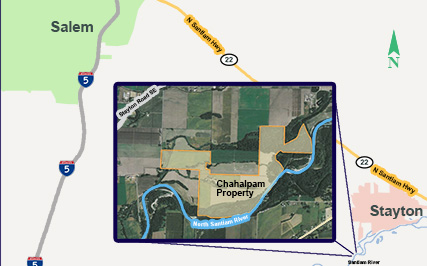Tribal Government & News
Tribe acquires 338-acre Chahalpam property in Marion County

Using Bonneville Power Administration funding, the Confederated Tribes of Grand Ronde has acquired 338 acres on the North Santiam River southeast of Salem in Marion County and just downstream from Stayton.
The Chahalpam property is valued at more than $3.5 million. "Chahalpam" means "place of the Santiam Kalapuya."
"Not only did the Tribe receive outside funding for the entire purchase, there are several hundred thousands of dollars of BPA funding available for our management of the property," said Tribal Land and Culture Department Manager Jan Looking Wolf Reibach. "Equally, if not more significant, is the value of recovering our historic treaty lands for the Tribal membership."
Chahalpam is within the traditional homelands of the Santiam Kalapuya, one of the ancestral bands that formed the Confederated Tribes of Grand Ronde. The property has been farmed for many decades, but still features more than 100 acres of riparian gallery forest and more than a mile of river frontage.
The property was acquired through BPA's Willamette Wildlife Habitat Agreement, a 15-year agreement that requires BPA to provide stable funding for habitat acquisitions in the Willamette Basin to offset the effects of federal dams on the Willamette River and its tributaries. The land will be protected in perpetuity with a conservation easement that guarantees that it will be managed by the Tribe for fish, wildlife and other conservation values, with an emphasis on restoring the land to a more natural, indigenous condition.
"This is a monumental Tribal acquisition of land that will forever protect important natural and cultural resources in our ceded lands," Reibach said.
The Tribe must now draft and implement a management plan that will convert the agricultural fields and a home site to cultural plants and native habitat over time.
Previously, the property was permitted for gravel mining.
"Without the hard work of BPA, the Western Rivers Conservancy and the Tribe, it would likely be mined for gravel today rather than protected for our future generations," Reibach said.
The Chahalpam property is home to spring Chinook salmon, winter steelhead, Pacific lamprey, Oregon chub, western red cedar, Oregon ash and red-legged frogs among other native plant and animal species.
Reibach credited Tribal Council for its "persistence and support for a greater presence in our ceded lands" and the Ceded Lands Acquisition Team, which includes himself, Ceded Lands Manager Michael Karnosh, Tribal attorneys Jennifer Biesack and Ryan Sudbury, Hydrosystem Compliance Specialist Lawrence Schwabe, Natural Resources Department Manager Michael Wilson and Tribal Realty Specialist Teresa Clay for putting in long hours and intense work to bring the acquisition to fruition.
"We're very fortunate to have a Tribal Council that is so supportive and action-oriented to lead us in such a massive undertaking," Karnosh said. "In addition, the combination of programs into the Land and Culture Department really streamlined things for this complex land transfer."
"The process for this project is very intensive with many steps and requirements that demand a high level of coordination by the Tribe with many offices and agencies," Reibach said. He also thanked the Tribe's Cultural Protection Program and its partners at BPA and the Western Rivers Conservancy for making the acquisition possible.
"Through everyone's hard work the Tribe is making the dream of the return of its ceded lands a reality," he added.
The Chahalpam acquisition brings the Tribe's conservation land holdings in its ceded lands to 435 acres. In 2012, the Tribe acquired 97 acres at Rattlesnake Butte in south-central Willamette Valley near Junction City.
"This total will certainly increase as the Tribe pursues further conservation projects in its ceded lands," Reibach added.
